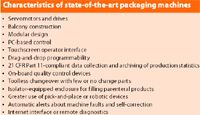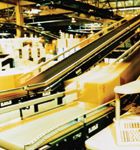State-of-the-Art Packaging Machines
Pharmaceutical Technology Europe
Packaging machines for new or existing lines are easier to operate and change over than they ever were before. Today's packaging machines also accommodate a greater variety of heights, diameters, finishes, or dosage regimen counts.
Packaging machines for new or existing lines are easier to operate and change over than they ever were before. Today's packaging machines also accommodate a greater variety of heights, diameters, finishes, or dosage regimen counts.

Characteristics of state-of-the-art packaging machines
These benefits are mainly a result of the replacement of mechanical parts such as gears, shafts and cams with electronic components such as servomotors and drives. Fully electronic motion control allows each function to be servocontrolled so that product and format changes can be executed at the touch of a button and manual adjustments can be minimized. "All servo machines allow operation across a virtually infinite set of parameters," says John Kirk, vice president of sales, liquid packaging and pharmaceutical operations at Robert Bosch Packaging Technology, Inc. (Minneapolis, Minnesota, USA).
This adjustability not only enhances flexibility and accuracy, but may also increase uptime and reduce product waste. For example, if a servocontrolled vial-filling monoblock with multiple heads experiences a problem with one head, that head can be turned off while the remaining heads continue to fill and the closing station compensates accordingly.Without this capability, the entire machine would have to be shut down, and product and production time would be lost. Other innovations in today's state-of-the-art packaging equipment include modular designs and balcony, or cantilevered, construction. The former makes it easy to add features and expand machine capabilities as needs change. The latter improves machine hygienics and operator ergonomics because motors, drives, and other moving parts are placed behind a vertical wall rather than below the machine. This position not only separates particulate-generating activity from the clean areas but also improves accessibility of these parts for maintenance and service, and results in a narrow machine that is easy for operators to reach across. In addition, a balcony design streamlines airflow around the machine because there are fewer horizontal surfaces to impede it.

Computer control trends
Another trend is the replacement of programmable logic controllers with PC-based control. Computer control combined with servotechnology expedites shutdown and startup, and increases productivity. It can also provide feedback control whereby the system monitors machine performance and can self-correct if operations start drifting out of specifications. However, many pharmaceutical manufacturers prefer that adjustments be made by a qualified operator and simply program the controller to provide alerts about off-specification trends or fault conditions.
Operator interfaces have moved from panels with buttons, switches, and knobs to easier-to-use touch screens. Software for these control systems and operator interfaces often is Windows NT- or Windows XP-based, which are systems familiar to many operators, thus shortening the learning curve. Typical features include graphical depictions of machine performance, drag-and-drop programmability for easy set-up and changeover, and data collection and archiving of production statistics. The latter is particularly essential for compliance with 21 CFR Part 11 requirements related to electronic signatures and record keeping.

Control systems can also provide access to machine manuals, documentation and extended diagnostics. An intranet or Internet interface makes it possible to monitor machine operation remotely by means of a standard web browser. This interface can alert operators and supervisory personnel about machine faults through e-mail, a pager, or a cell phone. In some cases, fault alerts can also be directed to the machinery builder's technical support staff for remote diagnostics and repair, or the dispatch of service personnel.
Additional features
Other state-of-the-art features include an integrated uninterruptible power supply so that data are not lost in the event of a power failure and inline quality control devices such as vision systems or checkweighers. With onboard quality control devices, 100% inspection can be achieved without the need to slow line speeds. If 100% inspection is not desired or practical, systems can be set to automatically check a designated sampling of containers.
Today's electronic machines typically require fewer change parts than did their mechanical predecessors. However, sometimes change parts are needed because the finishes, diameters, or heights of the containers to be run on the line are too different to share tooling. In such cases, changeover is expedited by the use of quick-connect/disconnect hardware, toolless adjustments, colour-coded change parts and standardized parts trolleys. The latter arranges parts on a cart in an orderly sequence so that operators or mechanics have everything that is needed for changeover at their fingertips. Although pharmaceutical manufacturers have not adopted isolator-equipped machines as quickly as some experts had expected, there is a clear trend toward these machines that create a clean room environment within an enclosure.
"Isolator equipped machines were viewed as a large risk, but now they are seen as viable," explains Jeffrey Jackson, product manager of pharmaceutical operations at Bosch. "Everyone is going to be adopting it in 5 years," he predicts. "FDA has started to be more clear about the benefits of isolator technology," notes Kirk. "Some manufacturers are adopting isolator equipment to be proactive, assuming it will eventually be required," he adds. A number of factors are driving pharmaceutical manufacturers to purchase state-of-the-art equipment. "Regulatory requirements are a huge driver," says Kirk. Another major influence on new equipment specifications is the proliferation of drugs and packaging formats, which is spurring demand for flexible machines that can handle a wide range of container sizes and shapes. In today's pharmaceutical production facilities, it is not uncommon to fill 15 or more different vials on the same line, particularly in the US where vial sizes are less standardized than in Europe. Moreover, the evolution of new technology is also encouraging investment in new equipment.
Flexibility
Flexible machines are particularly useful at companies that must perform frequent short runs, such as clinical trial packagers, because changeover is simple and less time consuming. This means shorter downtime for line cleaning and setup. In fact, because the results of clinical trials are extremely influential to the future marketing of a new drug, "FDA wants clinical trial packaging to reflect the production environment as closely as possible," says Kirk.
The demand for flexibility is also driving increased adaptation of pick-and-place devices for functions such as tray loading, checkweighing, quality control sampling and carton/case loading. An example of the marriage of servo and pick-and-place technologies is a new trayloader design (TRL 1030 trayloader, Bosch). Servomotors and drives eliminate the complexity of earlier, more mechanical designs and replace them with smooth, reliable and flexible motion controls that ensure a cleaner operation and minimize vial acceleration and splashing. A trayloader's function is to load filled vials onto trays in a designated pattern for storage or transport for further processing such as freeze-drying. The new trayloader is designed to gently pick and place vials reducing the possibility of breakage. The unit is compatible with four-sided trays or trays with the holding ring already in place - a favoured design because it eliminates the need for the operator to lean over the tray to place the ring. "We began the redesign of the trayloader looking at ways to improve the motion of the machine and give the customer greater flexibility," says Al Peterson, product development manager at Bosch. The servo-controlled robotic function eliminates the need to have fixed cams, gears and levers, and the control system makes it easy to adjust the machine to accommodate various container and tray sizes and loading patterns.
The addition of servo controls creates a faster, less expensive system that requires less maintenance and fewer repairs. Further efficiency is gained with the use of a colour touchscreen operator interface. The TRL 1030 unit can handle trays that measure up to 40Ã24 in. (an increase of 12.5% from the previous model) while maintaining the same footprint as the earlier version. It will load as many as 400 vials/min and as many as 20 rows/min, depending on vial size and tray width. Vial sizes can range from 2-250 mL and the system holds recipes for adjusting the machine for various vial sizes. The tray can handle other sizes with minimal change parts. An open design allows unidirectional airflow and cleaning. Another trend among equipment suppliers is a growing emphasis on integration and support. Increasingly, machinery manufacturers not only provide the equipment they build, but also integrate these units with up- and downstream machines from other manufacturers to assemble turnkey lines. This integration may include related infrastructures such as clean room walls and the heating, ventilating and air conditioning systems that deliver unidirectional airflow to filling areas in controlled environments and vial sterilization-depyrogenation ovens.
The article originally appeared in the January 2004 issue of Pharmaceutical Technology.
Hallie Forcinio is Pharmaceutical Technology's Packaging Forum editor, 4708 Morningside Drive, Cleveland, Ohio 44109, USA. Tel. +1 216 351 5824 Fax +1 216 351 5684 editorhal@cs.com
www.pharmtech.com

Pharmaceutical Tariffs Are Imminent: How Industry is Bracing for Impact
April 16th 2025On April 14, 2025, the Trump Administration launched a national security-driven investigation into pharmaceuticals, a move that will likely result in tariffs being placed on pharmaceutical drugs, ingredients, and other components that are imported from outside of the United States.
Drug Solutions Podcast: A Closer Look at mRNA in Oncology and Vaccines
April 30th 2024In this episode fo the Drug Solutions Podcast, etherna’s vice-president of Technology and Innovation, Stefaan De Koker, discusses the merits and challenges of using mRNA as the foundation for therapeutics in oncology as well as for vaccines.